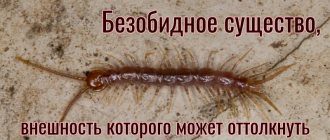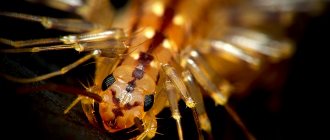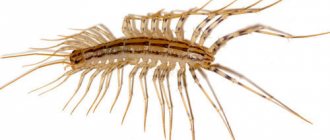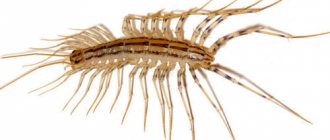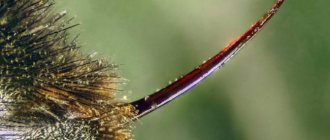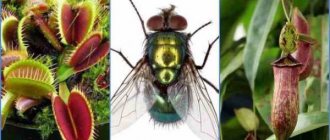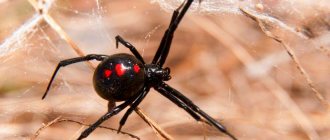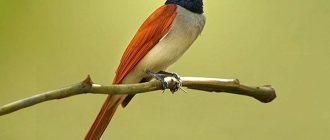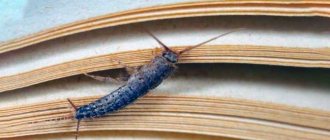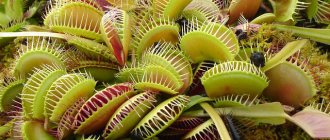The common flycatcher insect, Scutigera coleoptrata, is a small, typically yellowish-gray centipede with 15 pairs of long legs. Originating in the Mediterranean region, this species has spread to other parts of the world. Can live in human houses and apartments. hence the name house flycatcher. Insectivore, kills and eats other arthropods such as arachnids.
The common flycatcher is like a spider on steroids. Your first reaction to her is to kill. But no matter how scary it may look, the house centipede, Scutigera coleoptrata, is truly harmless. And if you have other pests in your apartment or house, it will be beneficial.
What does a flycatcher insect look like?
Even people who appreciate insects can be overwhelmed by the common flycatcher. An adult reaches 4 centimeters in length, but long legs make it larger. The last pair of legs of the female is twice as long as the body.
The house flycatcher is light yellow-brown in color with three dark longitudinal stripes along the body. The legs are marked with alternating light and dark stripes. They have large compound eyes, which is unusual for centipedes.
Although it has venom, it rarely bites anything larger than itself. If you are bitten by a Scutigera coleoptrata flycatcher, you are unlikely to suffer much pain. Be careful to clean the wound to prevent secondary infection.
Compression phase
If the initial slam of the trap is successful, the compression phase begins, which lasts about half an hour. The process looks like this. During the struggle, the insect inside the trap continues to touch the “trigger hairs.” This signals the flycatcher that it needs to further clamp the flaps to keep the victim inside. If the insect is small enough, it can slip through the teeth of the trap and escape.
The compression phase does not occur if the slamming is unsuccessful in finding prey. This happens if, when the flaps collapse, the insect manages to get out of the trap or vibrations of the hairs occur, caused by other leaves, raindrops, or a person who stuck his finger there. Then the trap begins to slowly open and opens completely in a day or two. But if such touching of the hairs occurs several times, it can lead to blackening and death of the trap. In subsequent times, the rate of collapse of the same trap drops significantly.
What do they eat at home?
Common flycatchers are skilled hunters that prey on insects and other arthropods. Like all centipedes, the front legs develop into "poison claws" used to inject venom into prey.
They provide effective (and free) pest control services for your home because they feed on silverfish, fire ants, cockroaches, carpet beetles, and other household pests.
Natural enemies
The natural enemies of the centipede scutiger are birds and other animals. But quite a few animals prefer centipedes as food. Therefore, the main threat to them is a person who exterminates all the “creepy creatures” that come his way.
Disinsection services remove not only harmful creatures from homes, but also useful creatures such as flycatchers.
Millipede populations are declining due to ongoing human activity in the areas of logging, farming and pesticide use. The extinction of this species could have a negative impact on the ecosystem, which could lead to even more harmful insects.
Interesting behavior
The flycatcher makes good use of its long legs. Can move at alarming speeds - the equivalent of over 64 kilometers/hour in human terms. This will scare even the most die-hard arthropod lover. Athleticism doesn't have to scare you. The house flycatcher is simply well equipped to stalk and catch prey.
Find out more Rat bite: what it looks like, how dangerous it is, how to treat it
Just as their speed helps them capture prey, it also allows centipedes to avoid predators. If the predator manages to grab the leg, it throws the limb away and runs.
Oddly enough, the severed leg will continue to move for several minutes after its owner leaves the stage. They shed even as adults and regenerate lost limbs.
Mechanical methods of struggle
Mechanical methods include sticky traps, vacuuming, pressing, and trapping.
By the way, sticky traps are not very effective against flycatchers. They will simply leave a few of their legs on the Velcro and run away, and after a while they will grow new legs.
It's best if you just catch the centipede in a jar and take it outside.
Where live
Whether outdoors or indoors, the flycatcher prefers cool, damp, dark places. In its natural habitat it can be found under fallen leaves, crevices, rocks, and tree bark. In people's apartments, house flycatchers live in basements and bathrooms. In northern climates they remain indoors during the colder months, but can be seen outside from spring to fall.
It is believed that their homeland is the Mediterranean region. But Scutigera coleoptrata is widespread in Europe, North America, and Asia.
Why can't you kill a flycatcher?
Although house flycatchers, scutigers, are scary-looking and move quickly, they provide us with a great service. Centipedes protect our homes from harmful insects that carry various bacteria and spoil our food and clothing.
For example, a moth is not as scary in appearance as a flytrap, but it can irrevocably destroy your expensive clothes or fabric upholstery. While the centipede does not damage furniture, books, clothing and food, but on the contrary, it destroys all known pests.
If you have a Scootiger centipede in your house, leave it alone. Just try to put things in order in your apartment or summer cottage. Remove firewood from the ground and burn fallen leaves. Ventilate the room more often and try to reduce the percentage of air humidity.
If there are too many centipedes in an apartment or country house and you see them every day on your way, then you should think about forcibly reducing their population. The methods described below will help with this.
Morphology
The body of an adult Scutigera coleoptrata ranges from 25 to 35 mm in length. Up to 15 pairs of long legs are attached to the rigid body. Together with the antennae, they create a centipede with a length of 75 to 100 mm. Thin legs allow you to reach amazing speeds of up to 0.4 meters per second, running along the floor, up walls, along ceilings.
The body is yellowish-gray and has three dark dorsal stripes running along its entire length. The legs also have dark stripes. The tail-like hind legs have the appearance of antennae. When at rest, it is not easy to distinguish the head from the back.
Unlike most other centipedes, house flycatchers have well-developed faceted eyes.
Who is a centipede
The biological name of this creature is the common flycatcher or house centipede. According to the classification, the centipede is not an insect, but belongs to the group of arthropods, the class of the same name and the tracheal type. There are thousands of species of centipedes in nature. Their habitat is damp and dark places: foliage, shelters under bark and stones, etc.
Millipedes go hunting at night and hide during the day. The body of an adult centipede is divided into 15 segments, each of which has legs. Their sizes along the body are different: closer to the tail, the legs become longer, which allows them not to get tangled with each other when moving.
Outwardly, it is difficult to determine where her head is and where her back is. In addition, the front pair of legs evolved and turned into jaws designed for capturing prey.
The flycatcher has a chitinous cover and a flattened body. There are small hairs all over the surface of the body, which is why some people call them hairy centipedes. The average length is 3-4 cm; occasionally larger individuals up to 6 cm are found.
Interesting!
The speed of movement of a house flycatcher can reach 40-60 cm per second; such a fast-running creature often frightens ignorant and nervous people. They can move both on horizontal and vertical surfaces: on the floor, walls or ceiling. The number of limbs depends on the type of centipede and can reach 354 pieces.
Common flycatcher
As can be seen from the description and photo of the centipede, on its head are located:
- compound eyes that see perfectly;
- long mustache-catchers, resembling a whip in shape, with their help they monitor all changes in the environment;
- the whiskers consist of 500-600 segments and react to temperature changes, help explore and navigate in space, and find safe places.
The color of an adult individual is gray-yellow, brown, with 3 purple or black stripes on the back. During the cold season, flycatchers crawl into secluded corners and freeze in order to “wake up” in the spring and return to active life again.
Reproduction and development
They lay eggs in the spring. During laboratory observations of 24 house centipedes, they laid 63, or a maximum of 151, eggs. Like many other arthropods, the larvae look like miniature versions of the adults, but with fewer legs.
The young have four pairs of legs when they hatch. They get a new pair with the first moult and two pairs with each of the next five. Adults with 15 pairs of legs maintain this number for three more molting stages (sequence 4-5-7-9-11-13-15-15-15-15 pairs).
The common flycatcher lives from three to seven years, depending on the environment. They begin to reproduce in the third year. Before mating, the male and female circle around each other. Contact is initiated by antennas. The male deposits sperm on the ground and the female uses it to fertilize the eggs.
Find out more How long do rats live, what are they afraid of, how to get rid of them
How to get rid of centipedes in residential areas?
Flycatchers can live in the house for quite a long time. To destroy them, you can use folk, chemical and mechanical methods.
Folk remedies for fighting centipedes
Homemade poison traps should be placed in places inaccessible to pets and children.
- Boric acid is an affordable remedy for flytraps, and it also helps get rid of other parasites in the house. They do not tolerate the effects of the product well. It can be poured under the bathtub, behind water pipes and in cracks.
- To combat the centipede, you can use ground red hot pepper. Traps should be placed under the bathtub, pipes and other places.
It is possible to get rid of insects using synthetic and natural components only if their numbers are small.
Mechanical methods of dealing with centipedes
- The simplest method is to kill the insect with a slipper. But it is not very pleasant, since then you will have to remove its remains from the floor or walls. It is also worth considering that flycatchers run quickly, which causes panic in humans and complicates the process of hitting it. This method can hardly be called humane, since they benefit people by ridding the house of cockroaches, moths, flies, ants and other living creatures.
- Catch the centipede and take it outside the living area.
- If a lot of insects and their offspring appear in the house, it is necessary to carry out a set of measures for extermination: get rid of mold and dampness, dry towels, rags for the floor on the loggia, and not in the bathroom, seal all holes and cracks in the walls, floors, baseboards , deprive flycatchers of food and others.
- In a private house, you need to remove foliage from the ground in which centipedes live, garbage and climbing plants from the walls from the street, since centipedes crawl along them into the room. All that remains is to catch the individuals inside the building.
Chemical methods of controlling centipedes
If there is a large concentration of flycatchers and their nest is identified, there is no need to waste money and effort on traps, since in this case they will be ineffective. Insecticides are guaranteed to help rid your home of them. However, it is recommended to use them only if eliminating high humidity in the rooms and folk remedies have not helped.
- Raid aerosol for killing crawling and flying insects. The product has low toxicity for people, but after treating the room it must be ventilated.
- Combat is an effective insecticide that quickly destroys insects in the house.
- Aerosol with active insecticidal action Clean home. The product is effective against crawling and flying insects. Centipedes live in places with high humidity, there are not many of them in the house, so one bottle is enough for about two or three treatments. It can be used to destroy flycatcher nests.
Behavior
They feed on spiders, bed bugs, termites , cockroaches, silverfish, ants, and other domestic arthropods. The poison is secreted through the forcipules. Not through the lower jaw, so they burn and do not bite. These are night hunters.
Despite their developed eyes, they rely on their whiskers to hunt. The antennae are sensitive to both odors and tactile information. They use mandibles and legs to hold prey. Thus, they can deal with several small insects at the same time.
To catch prey, they either jump on it or use their legs in a technique described as a "lasso". The use of legs to subdue prey is also described.
They have adapted their feeding pattern to the type of danger the prey may pose to them. For wasps, retreat after applying the poison to give it time to take effect.
When the flycatcher is at risk of becoming prey, it can detach the legs that are trapped. It has been observed that Crimean flycatchers groom their legs by curling up around them.
1902, CL Marlatt, US entomologist, made a brief description:
“You can often see them rushing across floors at very high speeds, sometimes stopping suddenly and remaining absolutely motionless. Then they resume their rapid movements, rushing straight at the inhabitants of the house, especially women, obviously with the desire to hide under their dresses. They create a lot of fear.”
What does the centipede flycatcher eat?
The flycatcher is a predator; it infects its prey with poison and then eats it. It feeds on flies, termites, spiders, cockroaches, fleas, termites, moths, silverfish, aphids, fireflies, worms, snails, beetle and fly larvae, as well as other small arthropods. The flycatcher does not disdain plant food. In some cases, it can even feed on house plants.
The flycatcher waits for its prey, sitting motionless in ambush. Having seen or smelled the prey with its mustache, the centipede gives chase and grabs the insect with its long legs, injects poison and begins to eat the prey. If the hunt was successful and several insects were caught at once, she holds them with her legs, eating them in turn.
Where do they meet?
Outdoors, house flycatchers prefer to live in cool, damp places. The respiratory system of the centipede does not provide a mechanism for closing the spiracles. They need an environment that protects them from dehydration and excessive cold.
Most live outside, under large rocks, piles of wood, especially compost piles. Inside apartments they are found almost everywhere. Most often they live in basements, bathrooms, toilets, and restrooms. But they can be found in dry places such as offices, bedrooms, dining rooms.
The greatest chance of meeting them is in the spring, when they come out because the weather is getting warmer. In autumn, when the weather is cold, they look for shelter closer to humans.
Watch the video - why you can’t kill a flycatcher
Danger to humans
The flycatcher poses no threat to humans. The insect is very secretive and tries not to be seen, and when faced with danger it tries to escape. It can only bite in self-defense if you try to pin it down. Centipedes also do not tolerate any diseases or parasites.
People are most often afraid of flycatchers because of their unpleasant appearance - many long, quickly moving limbs inspire horror and disgust . In addition, this harmless centipede is often confused with its poisonous relative - the scolopendra, which is similar in appearance, and therefore they mistakenly try to get rid of it.
The centipede will also not cause any harm to a person’s home. This insect feeds exclusively on flies, mosquitoes, cockroaches and other bugs and does not touch human food supplies. Furniture, clothing, wallpaper and paper products are also not included in his diet. Thanks to this, flytraps in the house are very useful - they quickly exterminate pests without side effects. Some summer residents even specially bring them to the site in order to remove flies, cockroaches, moths, ticks and other harmful “neighbors”.
Spreading
C. coleoptrata is native to the Mediterranean region. But it has spread to most of Europe, Asia, North and South America, Chile, and Los Lagos regions.
South Africa - found in the Western Cape, Cape Town area (Vredehoek, Mowbray, Edgemead, Green Point, Zonnebloem, Woodstock, Stellenbosch, Gordon's Bay), KwaZulu-Natal province, Pietermaritzburg.
Learn more 10 simple tips for cleaning your home from pet hair
The flycatcher can be found in eastern and southern Australia, from Perth to Adelaide, South Australia, to Sydney, New South Wales, Tasmania. Other countries where they have been discovered include New Zealand, Japan, and South Korea. Relatively rare for South and Southeast Asia.
Features and life cycle
Like many other centipedes, such as the centipede, the flycatcher is an active predator. The arthropod is active both day and night. Spends a lot of time waiting for prey. One of the main features of the flycatcher is the speed at which it can move. She can cover 40 cm in 1 second.
The process of fertilization in these centipedes is very interesting. Mating in its usual form does not occur between a male and a female. The male, in the presence of the female, lays a spermatophore (a capsule filled with sperm). After this, he pushes the female onto him, who takes him in with the help of her genital appendages. After fertilization, the female lays eggs in the soil, covering them with a sticky substance.
A centipede hatched from an egg is similar in appearance to its parents, but has only 4 pairs of legs. With each molt, the number of limbs increases and after the fifth moult the flycatcher becomes an adult.
Biological details
The faceted eyes of S. coleoptrata are sensitive to daylight and very sensitive to ultraviolet radiation. They do not instantly change direction when light suddenly falls on them, retreating into a dark shelter.
Some of the plates covering the body segments fused and became smaller during the evolution to the modern state of S. coleoptrata. The resulting discrepancy between the segments and the dorsal plates (tergites) is the cause of the rigid body.
Another feature that distinguishes S. coleoptrata from other centipedes is that proteins for oxygen transport are found in their hemolymph.
Closing mechanism
The top of each side of the Venus flytrap trap is colored with anthocyanins, pigments that give the surface of the trap a red color. This coloring is the main bait for insects in this plant. The trap cells also secrete a sticky substance, which is a type of protein. After the insect crawls into the trap, it begins to flounder on the slippery and sticky surface, greedily licking off the substance, touching the trigger hairs that signal the trap to slam shut.
The trap closing mechanism of the Venus flytrap can be divided into four main phases:
- Initial slamming.
- Compression phase.
- Sealing phase.
- Re-opening phase.
The "descent hairs" are indicators for the plant, which by their vibrations determines that potential prey is trapped. If two hairs are touched at once or one hair twice in a row within 30 seconds, the trap slams shut in a tenth of a second.
The slamming motion of a Venus flytrap is one of the fastest movements that plants are capable of. The amount of time it takes for Dionaea muscipula to slam shut varies greatly depending on ambient temperature, light, plant health, and other factors. However, the trap of a healthy plant in warm conditions slams shut very quickly.
The details of the slamming process are actually quite complex. Scientists are currently researching this process and have put forward various hypotheses, which include an instantaneous increase in cell size and an "unstable latch state" that are under the control of this plant.
Recent research conducted in 2005 by Harvard scientists shows that the Venus flytrap's trap slamming mechanism is based on biochemical and elastic processes. They cause the leaf tissue to stretch to the point of instability, and after touching the hairs, the plant instantly pumps water into the leaf, causing slamming.
Interaction with people
Different from its tropical cousins with shorter legs but much larger, S. coleoptrata can live its entire life in an apartment, usually at ground level. Although often frightening unwitting housemates with their appearance and amazing speed, they are generally considered harmless to humans.
Bites are rare. However, the tips of flytraps are not strong enough to easily penetrate human skin. The stings are similar to a bee sting and the venom causes redness and swelling.
Methods for eliminating flycatchers in an apartment include drying out the areas where they live, eliminating large populations of insects in the premises, and repairing cracks in the walls.
The alternative is to allow them to live while allowing pests such as cockroaches, flies, moths, bedbugs, silverfish, earwigs .
Does the flycatcher bite? Is it dangerous for humans?
If a centipede feels threatened, it can deliver a painful bite that will break the skin and cause swelling and pain comparable to a bee sting. But the poison secreted by the flycatcher is not dangerous to humans and domestic animals. Local damage and redness will go away in a couple of days.
In most cases, the centipede cannot even bite through human skin, so there is no need to be afraid of a bite.
The flycatcher is afraid of people, so it will not purposefully attack a person or try to get into his ear.
Habits, instincts and life of the flycatcher: the most interesting
You should know that the centipede (the photo will not allow you to make a mistake) is an insect that is equally active at any time of the day. Every hour, every minute she looks for prey. As soon as the victim is identified, the flycatcher injects a portion of a toxic substance into it to neutralize it and only after that it eats it without haste. The insect is very fast, capable of covering up to 40 centimeters in one second.
On average, a female flyeater lays up to 6 dozen eggs at a time. All of them are protected with a sticky substance and placed in a hole or deep crack carefully dug by mom. The insect carefully wraps its body around the clutch of eggs and tries to close it from the outside world with its paws. In this way, the scolopendra “nurses” the eggs for many weeks, without leaving the nest even a centimeter, and does not eat or drink anything.
The common centipede is an insect with a mission. Being a representative of the most ancient inhabitants of the planet, it deserves special attention. At first glance, scary and unpleasant insects actually provide invaluable assistance to humans by eating a lot of pests, for example:
- flies;
- cockroaches;
- fleas;
- ants;
- bedbugs, etc.
There are up to 8,000 species of this insect in the world, but only 3,000 of them have been officially documented, such as the Chinese centipede, which reaches a quarter of a meter in length with a body of 23 sections, or the bright black African centipede with a body up to 28 cm long!
Almost none of the discovered species of centipedes are dangerous to humans. Yes, arthropods can bite, but all that a centipede bite can do is cause allergies, and then only in people who are prone to this kind of reaction with a slight increase in temperature and swelling at the site of the bite.
In the insect world, the centipede is one of the dominant predators with claws on the first segment. She is a carnivore, so she prefers clean meat from small insects. Large species can cope not only with invertebrates, but also with small reptiles, as well as worms, frogs, spiders and even birds.
